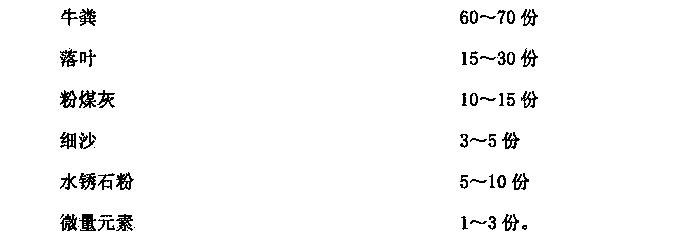Cold-temperature matrix for cultivating agaric
A cold-temperature, substrate-based technology, applied in applications, fertilizer mixtures, gardening, etc., can solve problems such as poor water absorption, low nutrient, substrate compaction, etc., and achieve the effects of optimizing constant temperature, increasing air permeability and heat dissipation
- Summary
- Abstract
- Description
- Claims
- Application Information
AI Technical Summary
Problems solved by technology
Method used
Image
Examples
Embodiment 1
[0023] A kind of cold temperature substrate for cultivating polyporus, in parts by weight, comprises the following components:
[0024] 60 parts of cow dung, 15 parts of fallen leaves, 10 parts of fly ash, 3 parts of fine sand, 5 parts of rust stone powder, and 1 part of trace elements.
[0025] Wherein, the cow dung is fully decomposed fermented cow dung, and its water content is 1-8%; the fallen leaves are poplar, apricot leaves, pear leaves; the trace elements are manganese, iron, magnesium, zinc , copper and boric acid; 20% of bean straw powder is added to the cow dung during the decomposing process; the fallen leaves are dead leaves with a water content of 20%, which are crushed and squeezed after collection, and then 10% of vinegar grains are added Fermentation was carried out for 8 days.
[0026] The added amounts of the trace elements are respectively: trace element manganese 1%, trace element iron 3%, trace element magnesium 3%, trace element zinc 1%, trace element c...
Embodiment 2
[0029] A kind of cold temperature substrate for cultivating polyporus, in parts by weight, comprises the following components:
[0030] 65 parts of cow dung, 25 parts of fallen leaves, 13 parts of fly ash, 4 parts of fine sand, 8 parts of rust stone powder, and 2 parts of trace elements.
[0031] Wherein, the cow dung is fully decomposed fermented cow dung with a water content of 1-8%; the fallen leaves are pine needles, poplar, apricot leaves, pear leaves; the trace elements are manganese, iron, magnesium , zinc, copper and boric acid; 30% of bean straw powder is added to the cow dung during the decomposing process; The vinegar lees were fermented for 12 days.
[0032] The added amounts of the trace elements are respectively: trace element manganese 2%, trace element iron 5%, trace element magnesium 4%, trace element zinc 2%, trace element copper 2.5%, boric acid 5%.
[0033] Put the above components into a mixing feeder, crush and sieve, and mix evenly to prepare a cold-te...
PUM
 Login to View More
Login to View More Abstract
Description
Claims
Application Information
 Login to View More
Login to View More - R&D
- Intellectual Property
- Life Sciences
- Materials
- Tech Scout
- Unparalleled Data Quality
- Higher Quality Content
- 60% Fewer Hallucinations
Browse by: Latest US Patents, China's latest patents, Technical Efficacy Thesaurus, Application Domain, Technology Topic, Popular Technical Reports.
© 2025 PatSnap. All rights reserved.Legal|Privacy policy|Modern Slavery Act Transparency Statement|Sitemap|About US| Contact US: help@patsnap.com


